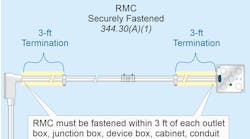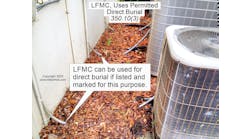Q. What are the lighting and switch location requirements for dwelling units?
A. There are more rules than many people think with these types of installations, and they are found in 210.70 (see Figure).
Dwelling unit lighting outlets
Habitable rooms — At least one wall switch-controlled lighting outlet must be installed in every habitable room and bathroom of a dwelling unit. See the definition of "Lighting Outlet" in Art. 100. There are two exceptions to this rule.
Exception No. 1: In other than kitchens and bathrooms, a receptacle controlled by a wall switch can be used instead of a lighting outlet.
Exception No. 2: Lighting outlets can be controlled by occupancy sensors equipped with a manual override that permits the sensor to function as a wall switch.
The Code specifies the location of the wall switch-controlled lighting outlet, but it doesn't specify the switch location. Naturally, you wouldn't want to install a switch behind a door or other inconvenient location, but the NEC doesn't require you to relocate the switch to suit the swing of the door. When in doubt as to the best location to place a light switch, consult the job plans or ask the customer.
Other areas — In dwelling units, not less than one wall switch-controlled lighting outlet must be installed in hallways, stairways, attached garages, and detached garages with electric power. At least one wall switch-controlled lighting outlet must provide illumination on the exterior side of outdoor entrances or exits of dwelling units with grade-level access.
The NEC doesn't require a switch adjacent to each outdoor entrance or exit. The Code considers switch location a "design issue," which is beyond the purpose of the NEC [90.1(C)]. For this reason, proposals to mandate switch locations have been rejected.
A lighting outlet isn't required to provide illumination on the exterior side of outdoor entrances or exits for a commercial or industrial occupancy.
Where the stairway between floor levels has six risers or more, a wall switch must be located at each floor level and at each landing level that includes an entryway to control the illumination for the stairway.
Exception: Lighting outlets for hallways, stairways, and outdoor entrances can be switched by a remote, central, or automatic control device.
Storage and equipment rooms — At least one lighting outlet that contains a switch or is controlled by a wall switch must be installed in attics, underfloor spaces, utility rooms, and basements used for storage or containing equipment that requires servicing. The switch must be located at the usual point of entry to these spaces, and the lighting outlet must be located at or near the equipment that requires servicing.
Guest rooms or guest suites
At least one wall switch-controlled lighting outlet must be installed in every habitable room and bathroom of a guest room or guest suite of hotels, motels, and similar occupancies. There are two exceptions to this rule:
Exception No. 1: In other than bathrooms and kitchens, a receptacle controlled by a wall switch is permitted in lieu of lighting outlets.
Exception No. 2: Lighting outlets can be controlled by occupancy sensors equipped with a manual override that permits the sensor to function as a wall switch.
Other than dwelling units
At least one lighting outlet that contains a switch or is controlled by a wall switch must be installed in attics and underfloor spaces containing equipment that requires servicing. The switch must be located at the usual point of entry to these spaces, and the lighting outlet must be located at or near the equipment requiring servicing. A 15A or 20A, 125V receptacle must be installed within 25 ft of HACR equipment [210.63].
Q. What are the support requirements for EMT?
A. Electrical metallic tubing (EMT) must be installed as a complete system in accordance with 300.18 [300.10 and 300.12], and it must be securely fastened in place and supported in accordance with 358.30(A) and (B).
Electrical metallic tubing must generally be securely fastened within 3 ft of every box, cabinet, or termination fitting, and at intervals not exceeding 10 ft. Fastening is required within 3 ft of termination, not within 3 ft of a coupling. Exception No. 1: When structural members don't permit the raceway to be secured within 3 ft of a box or termination fitting, an unbroken raceway can be secured within 5 ft of a box or termination fitting.
Electrical metallic tubing installed horizontally in bored or punched holes in wood or metal framing members, or notches in wooden members, is considered supported, but the raceway must be secured within 3 ft of termination.
Q. What receptacle outlets in a dwelling unit kitchen require GFCI protection and which don’t?
A. GFCI protection is required for all 15A and 20A, 125V receptacles that serve countertop surfaces in a dwelling unit [210.8(A)(6)]. However, GFCI protection isn't required for receptacles that serve built-in appliances, such as dishwashers or kitchen waste disposals. See 210.52(C) for the location requirements of countertop receptacles.




